Overview
The article titled "7 Community-Driven Conservation Models for Effective Land Management" emphasizes the critical role of local communities in conservation efforts aimed at effective land management. It illustrates how successful models, such as the Earth5R lake cleanup initiative and Namibia's conservancy model, reveal that community engagement not only enhances environmental outcomes but also cultivates local stewardship and economic advantages. This showcases the transformative potential of grassroots action in land conservation, underscoring the necessity for collective involvement in addressing land management challenges.
Introduction
In a world increasingly defined by environmental challenges, innovative, community-driven conservation models emerge as powerful solutions. From the shores of Lebanon's first natural park to the lush landscapes of the Amazon, local engagement proves essential for effective stewardship of natural resources. These initiatives not only enhance biodiversity but also foster economic resilience and social responsibility among communities.
As various case studies illustrate, when individuals unite to address ecological concerns, the results can be transformative—improving water quality, protecting endangered species, and promoting sustainable practices.
This article explores a range of successful models that highlight the critical role of community participation in conservation efforts, showcasing how collective action can lead to significant environmental and societal benefits.
Harbinger Land | Comprehensive Solutions for Land Services in Energy and Infrastructure
In the realm of energy and infrastructure projects across the United States, the complexities of land acquisition present significant challenges. Harbinger Land excels in delivering tailored land services designed to navigate these hurdles effectively. Their extensive portfolio includes:
- Site and right-of-way acquisition
- Title research
- GIS mapping
- Data processing
All aimed at addressing the intricate legal and regulatory requirements faced by clients.
By harnessing cutting-edge technology—such as AI-driven title research software and integrated GIS modeling services—Harbinger Land significantly boosts operational efficiency. This innovative approach not only enhances client satisfaction but also positions the company as a leader in the industry. With an experienced team adept at rapidly mobilizing large groups, Harbinger Land guarantees timely and precise services that meet the distinct needs of diverse clients, including natural gas companies, solar developers, and municipalities.
Moreover, the implementation of innovative document imaging solutions streamlines title research and leasing processes, effectively addressing the challenges that clients encounter in energy and infrastructure projects. This commitment to excellence is further underscored by Harbinger Land's dedication to client trust and data security, ensuring that every aspect of their service is handled with the utmost care and professionalism.
In conclusion, for those seeking reliable and efficient land services, Harbinger Land stands ready to deliver comprehensive solutions tailored to the unique demands of the energy and infrastructure sectors.
Earth5R | Community-Driven Lake Cleanup and Conservation Model
Earth5R has pioneered community-driven conservation models for lake cleanup that empower residents to actively restore and protect water bodies. This initiative not only targets the removal of pollutants from lakes but also emphasizes the importance of environmental awareness and education among local residents. By engaging citizens in hands-on activities, Earth5R promotes sustainable practices that significantly enhance the ecological health of nearby water bodies.
Recent statistics indicate that public involvement in lake preservation initiatives can lead to a 30% improvement in water quality over a five-year period. Furthermore, successful case studies demonstrate that initiatives led by local residents not only purify lakes but also cultivate a sense of stewardship and responsibility towards the environment.
The Earth5R model exemplifies how collective action can effectively tackle environmental challenges, showcasing the transformative power of community-driven conservation models in conservation efforts. As Earth5R states, "Communities can adopt similar models by focusing on local engagement, waste segregation, and upcycling." This philosophy aligns with insights from the Dharavi Model, which illustrates the potential for collective action to address operational and socio-cultural challenges in environmental efforts.
Ultimately, continuous education and engagement from all sectors are vital for achieving long-term environmental sustainability.
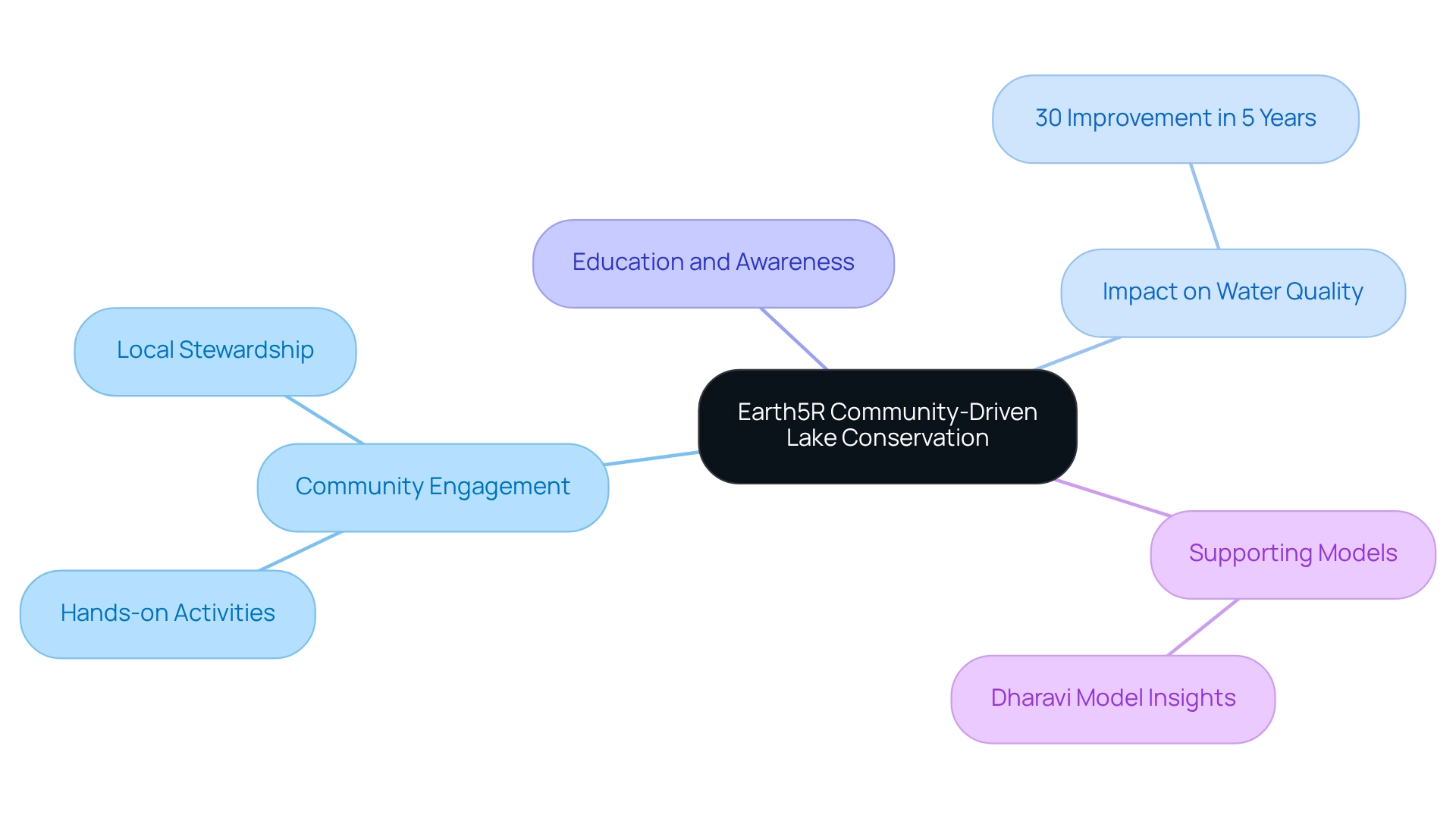
Herding for Health | Community Engagement in Sustainable Livestock Management
The Herding for Health initiative stands as a pivotal model for sustainable livestock management, emphasizing the critical role of public involvement. This initiative empowers rural populations residing near protected areas to manage their livestock in ways that not only enhance their livelihoods but also benefit the environment. By advocating for practices that improve rangeland health and mitigate conflicts with wildlife, Herding for Health illustrates the effectiveness of community-driven approaches. Such strategies not only lead to sustainable agricultural methods but also bolster regional economies, demonstrating a compelling case for the integration of environmental stewardship and economic resilience.
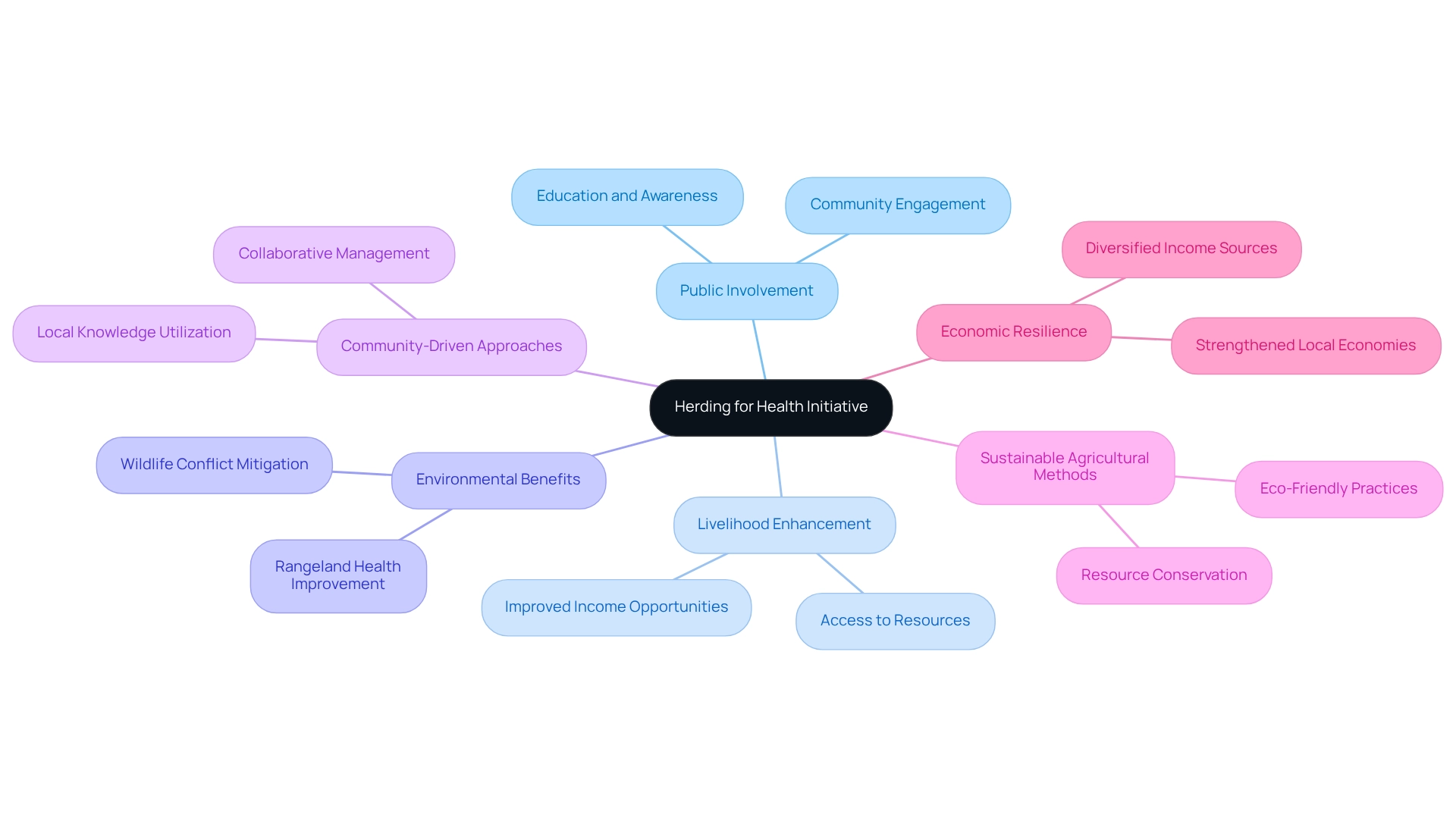
Community Conservancy Model in Namibia | Local Stewardship for Wildlife Conservation
Namibia's conservancy model exemplifies the power of regional stewardship in wildlife preservation. This innovative strategy, which utilizes community-driven conservation models by granting rights to local groups for the oversight of their natural resources, has significantly enhanced biodiversity and improved the livelihoods of surrounding communities.
Successful case studies from 2025 illustrate how these conservancies have led to marked increases in wildlife populations and habitat restoration, showcasing a clear economic impact on the involved groups. Furthermore, expert insights reveal that when local communities actively participate in community-driven conservation models for environmental protection initiatives, the balance of ecosystems is upheld, benefiting both nature and human societies.
As noted by Manzolillo Western & Nightengale, "When these practices are restricted, replaced, or otherwise compromised, the equilibrium of the entire system is at risk." This model serves as a compelling framework for regions grappling with similar environmental challenges, demonstrating the potential for community-driven conservation models that harmonize economic growth with conservation objectives.
It is crucial, however, to acknowledge the historical context of environmental protection in Africa to refine current practices. Additionally, the disruption of traditional human communities coexisting with wildlife poses risks to both natural and human environments, underscoring the need for integrated approaches that reconcile economic and conservation goals.
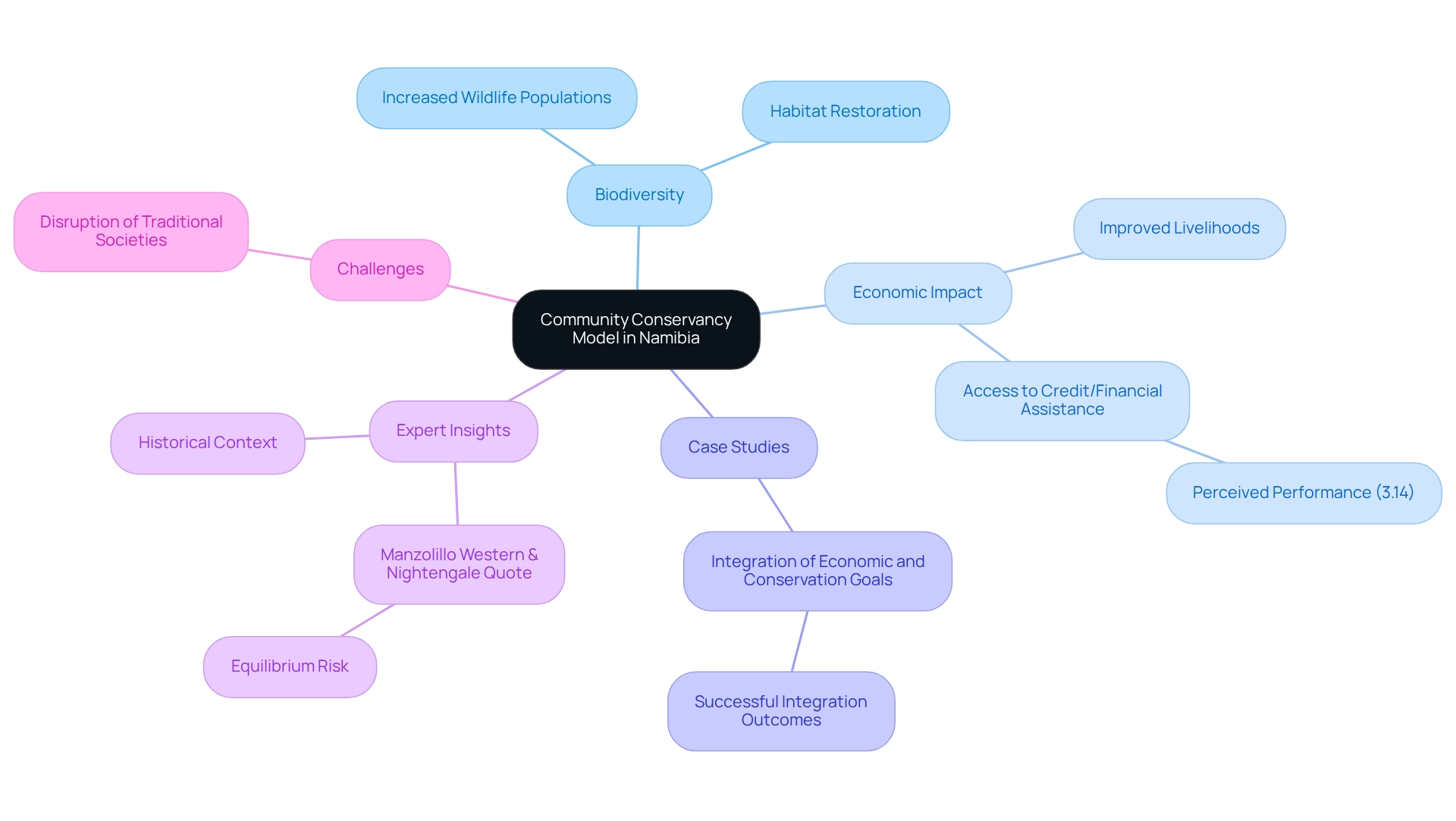
Lebanon's First Natural Park | Community-Driven Conservation Initiatives
Lebanon's first natural park stands as a testament to the power of community-driven conservation models. This initiative, guided by regional organizations, not only aims to protect biodiversity but also promotes sustainable tourism and societal development. By actively involving community stakeholders in the planning and management processes, the program develops community-driven conservation models that cultivate a sense of ownership and responsibility toward the natural environment.
Such community-driven conservation models have demonstrated successful preservation outcomes. When communities are engaged, the benefits extend beyond environmental protection to enhance local economies and foster sustainable practices. The impact of these programs is evident in the increased public participation in natural park management, which has been pivotal in advancing preservation initiatives and ensuring the long-term sustainability of Lebanon's rich biodiversity.
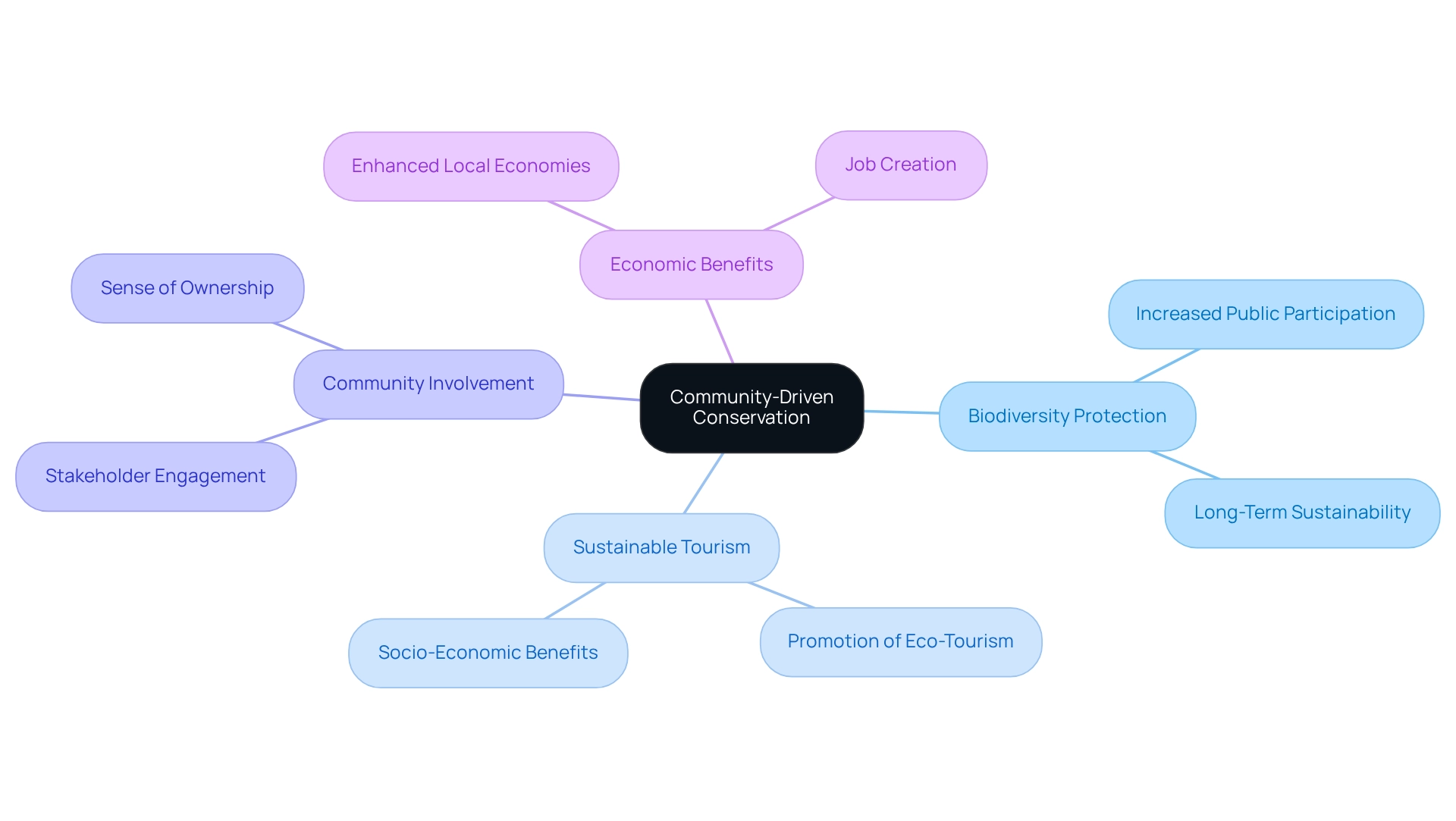
Indigenous-Led Conservation in the Amazon | Integrating Traditional Knowledge for Sustainability
Indigenous-led preservation initiatives in the Amazon are crucial for safeguarding biodiversity and promoting community-driven conservation models that support sustainable land use. By merging traditional ecological wisdom—such as crop rotation and allowing land to rest—with modern preservation strategies, these community-driven conservation models empower Indigenous groups to effectively manage their lands. This dual approach not only preserves cultural heritage but also bolsters ecosystem resilience, demonstrating the importance of community-driven conservation models and traditional knowledge in addressing contemporary environmental challenges.
The Wounaan-Nonam group exemplifies this model through their sustainable production of handicrafts and natural dyes, generating income while contributing to biodiversity protection and cultural preservation. Research indicates that community-driven conservation models, particularly those led by Indigenous groups, are significantly more effective in sustaining biodiversity. Studies reveal that areas managed by Indigenous communities often exhibit higher levels of ecological health compared to those under community-driven conservation models.
As stated by the Organización Nacional Indígena de Colombia, 'a decision of the Constitutional Court, Auto 004 of 2009, recognised this reason for the dispersal across the country far from their ancestral territories.'
As we approach 2025, it is imperative to acknowledge and integrate Indigenous rights and knowledge into community-driven conservation models, fostering sustainable practices that benefit both the environment and surrounding populations.
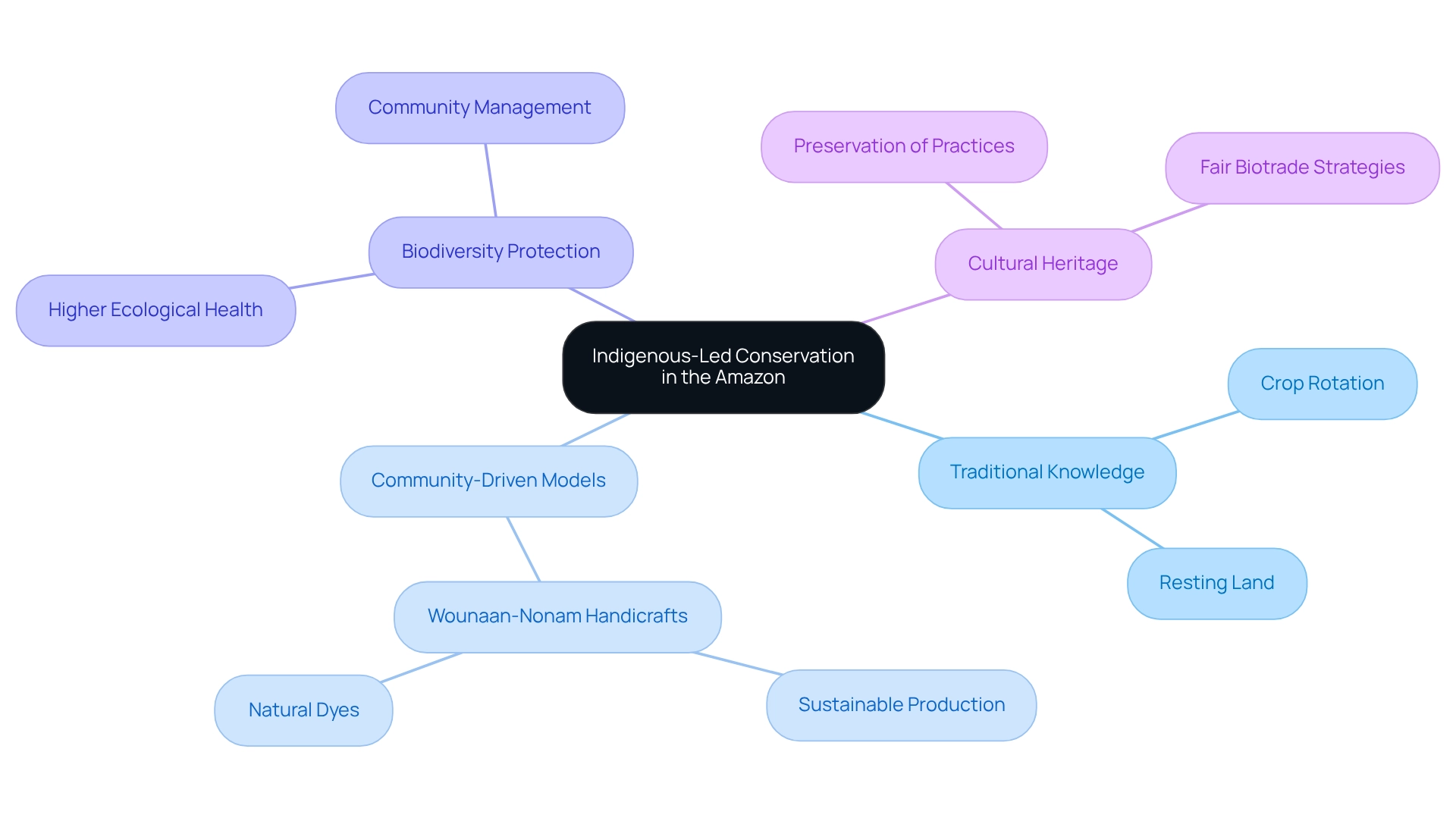
Leatherback Project | Community Engagement in Marine Conservation
The Leatherback Project exemplifies the power of community-driven efforts in protecting leatherback sea turtles. By actively engaging nearby populations in monitoring and protecting nesting sites, the initiative fosters a strong sense of stewardship and responsibility towards marine ecosystems.
Research shows that community involvement in marine protection projects can lead to significant positive effects on biodiversity. For instance, the Rights of Nature law in Panama assures the natural world's 'Right to Exist, Persist and Regenerate,' highlighting the increasing recognition of community involvement in preservation initiatives.
This model not only empowers community members but also promotes community-driven conservation models as a strategy for biodiversity preservation. Successful regional initiatives, such as beach clean-ups and educational workshops, demonstrate that when groups are involved, they can greatly enhance the effectiveness of conservation efforts.
Expert insights emphasize that community stewardship is essential for the long-term sustainability of marine species, fostering a vested interest in the health of the ecosystem. As poet Pablo Neruda eloquently stated, 'I need the sea because it teaches me,' capturing the intrinsic connection between humans and marine environments.
The Leatherback Project serves as an engaging case study, illustrating how grassroots participation can yield significant advantages for both wildlife and surrounding populations.
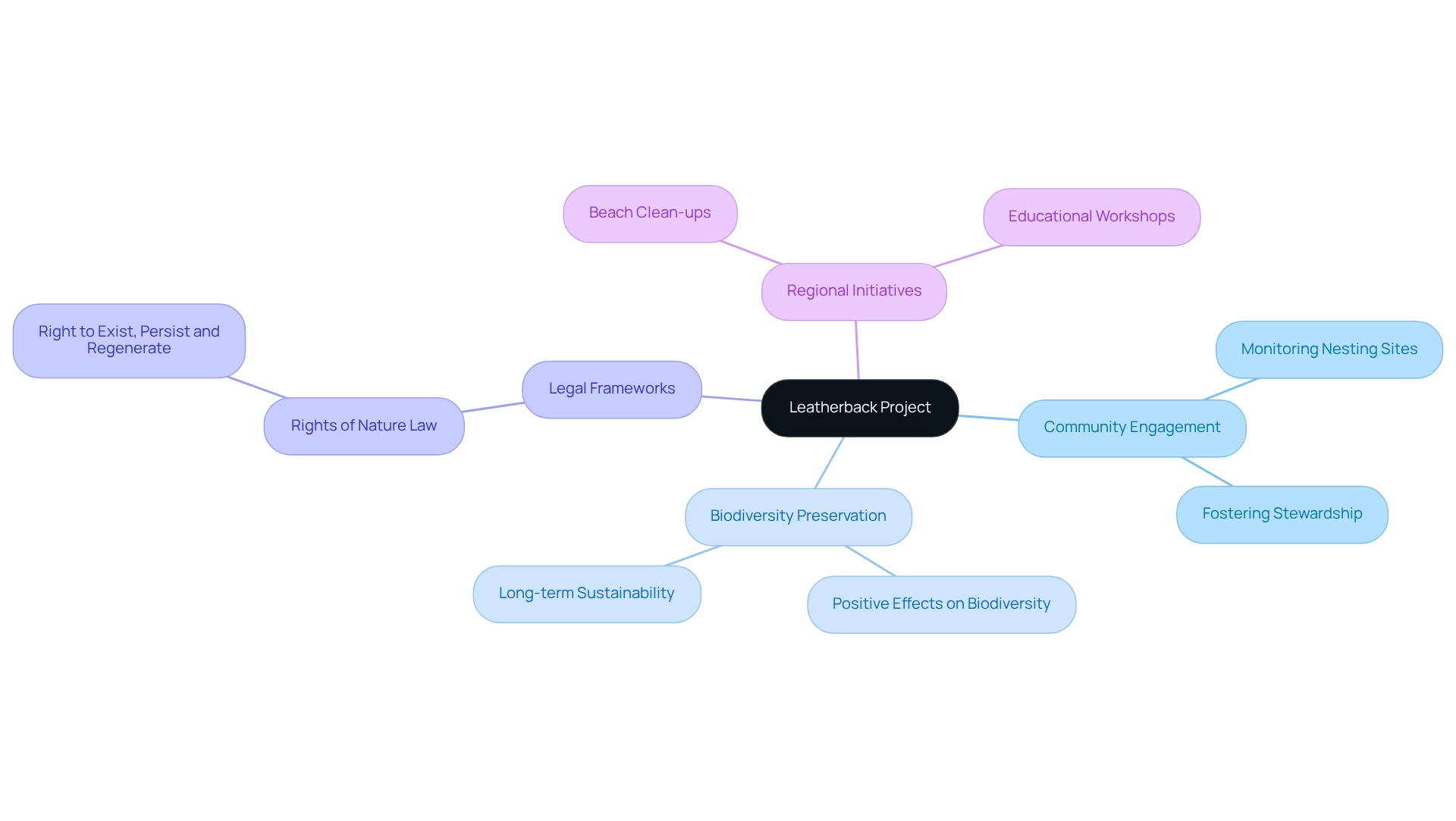
Community-Driven Conservation Models | Addressing Climate Change Through Local Action
Community-driven conservation models are pivotal in the fight against climate change, empowering local groups to embrace sustainable practices that bolster ecosystem resilience and enhance biodiversity and carbon sequestration. These initiatives not only mitigate environmental impacts but also facilitate adaptation to shifting climatic conditions.
Consider [[the Ecosystem-Based Adaptation and Livelihood Diversification project in South Ahuachapán; it exemplifies how restoring degraded landscapes, alongside community training and inclusive partnerships, can cultivate resilience in often-overlooked populations. Such models demonstrate that regional actions can yield substantial benefits.
For instance, farmer Mevin Pérez expressed gratitude for the irrigation systems that improve water availability for crops, ultimately reducing labor and enhancing productivity, which directly supports ecosystem resilience.
With G20 countries accounting for 80% of global emissions, the urgency for effective local strategies is evident. Nature-inspired solutions, particularly those from community-driven conservation models, are increasingly recognized as viable pathways for climate adaptation, underscoring their essential role in combating climate change.
By fostering collaboration and information exchange, these efforts not only contribute to climate mitigation but also elevate the overall welfare of communities, positioning them as critical components of sustainable land management.
Citizen Science in Conservation | Empowering Communities for Environmental Monitoring
Citizen science projects are pivotal in empowering communities to engage actively in environmental monitoring and data collection, which supports community-driven conservation models and enhances preservation efforts. These community-driven conservation models foster a sense of ownership and responsibility towards the environment by involving local citizens in scientific research.
For example, the more4nature project supports over 160 citizen science initiatives and collaborates with more than 95 authorities globally, illustrating the significant impact of community-driven conservation models on environmental protection. This engagement not only generates valuable data for community-driven conservation models but also enhances education and awareness, resulting in a more informed and proactive populace committed to environmental stewardship.
A compelling instance of community-driven conservation models is the grassroots biodiversity protection project in Bhutan, where local villagers established wildlife corridors and replanted native trees to safeguard endangered species' habitats while reinforcing their dedication to environmental stewardship for future generations.
As Margaret Mead aptly stated, 'Never doubt that a small group of thoughtful, committed citizens can change the world; indeed, it is the only thing that ever has.' Furthermore, Richard Rogers emphasized, 'The only way forward, if we are going to improve the quality of the environment, is to get everybody involved.'
This collective effort underscores the importance of public involvement in ecological research, showcasing the transformative potential of community-driven conservation models in addressing environmental challenges.
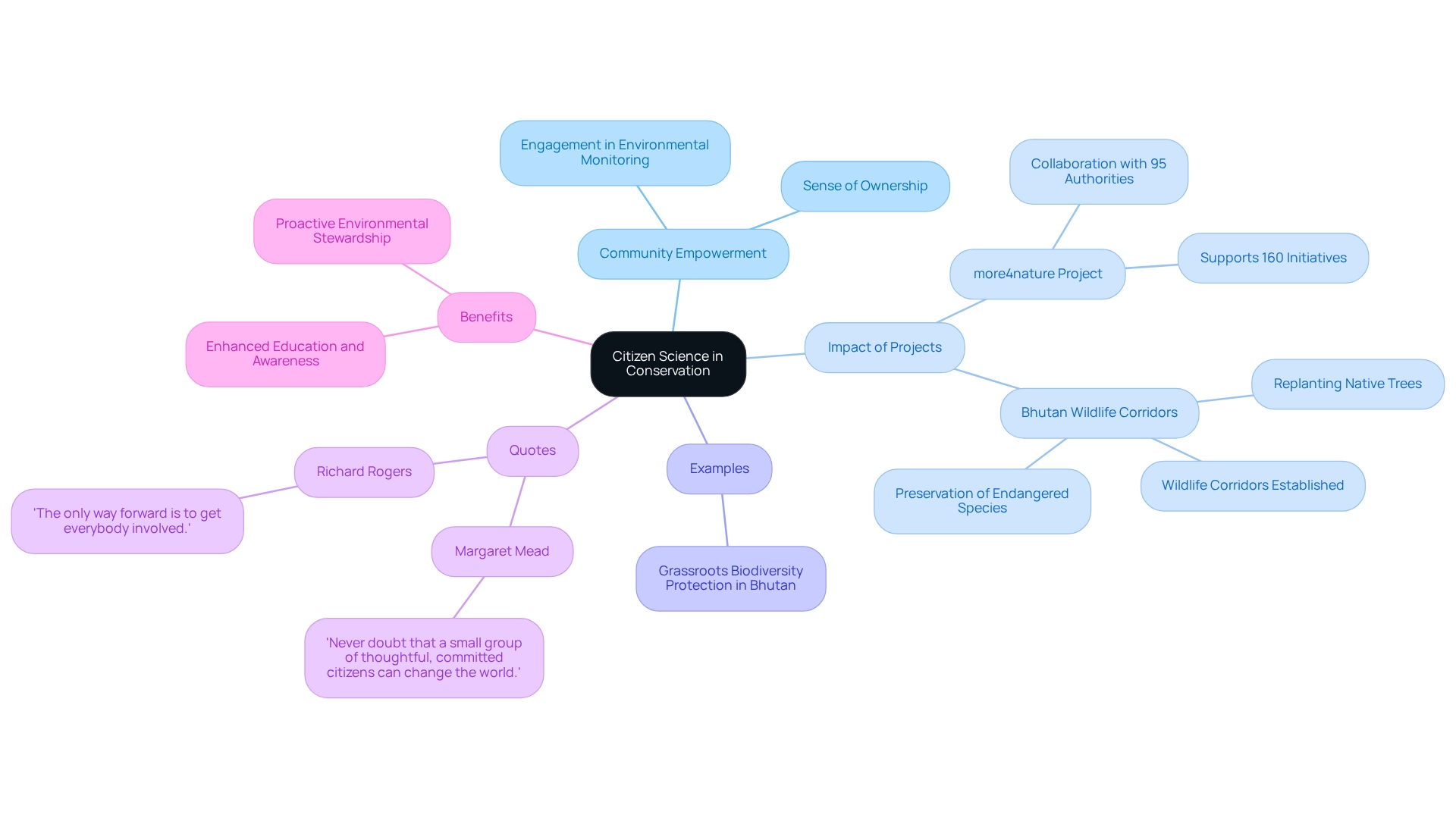
Policy-Level Collaborations | Enhancing Community Conservation Efforts
Collaborations at the policy level are paramount for advancing local environmental efforts. By aligning regional initiatives with overarching policy frameworks, stakeholders can secure vital support and resources for community-driven conservation models. Public agencies must prioritize funding for projects that enhance livability, as this demonstrates the beneficial impact of government backing on regional preservation initiatives.
Collaborative strategies that incorporate community-driven conservation models involving government agencies, NGOs, and local organizations yield more effective conservation outcomes, fostering sustainable practices that benefit both ecosystems and local communities. Recent advancements in 2025 illustrate how public agencies are increasingly prioritizing funding for initiatives aimed at improving livability.
Successful case studies, such as NeighborSpace's redefined communication strategies, underscore the significance of aligning messaging with local priorities to cultivate public support for green spaces. As Scout Leader Martin Nibali articulated, 'The scouts truly aimed to concentrate on service,' emphasizing the critical role of public involvement in environmental initiatives.
Furthermore, the development of Adelaide Bentley Park, which was shaped by community input and financed by the County, exemplifies how community-driven conservation models can lead to successful conservation results. These instances highlight the necessity of expert insights into how local initiatives can effectively align with broader policies, ultimately enhancing biodiversity and carbon sequestration efforts.

Conclusion
Community-driven conservation models have emerged as a powerful response to the pressing environmental challenges faced globally. By showcasing a variety of successful initiatives—from lake cleanups and sustainable livestock management to Indigenous-led conservation and citizen science—it becomes evident that local engagement is vital for effective stewardship of natural resources. These models not only enhance biodiversity and ecosystem health but also strengthen local economies and foster a sense of responsibility among community members.
The case studies discussed illustrate the transformative impact of collective action. When communities unite to tackle ecological concerns, the results can be significant. Initiatives like Earth5R and the Herding for Health program exemplify how grassroots involvement can lead to tangible improvements in environmental quality and sustainable practices. Furthermore, the importance of policy-level collaborations cannot be understated; aligning local efforts with broader frameworks enhances the effectiveness and sustainability of these initiatives.
As the world grapples with climate change and biodiversity loss, the need for innovative, community-driven solutions becomes increasingly urgent. The examples presented underscore the potential for local actions to yield substantial environmental and social benefits. By empowering communities to take an active role in conservation, a more resilient and sustainable future can be forged—one where both people and nature thrive together. Embracing these models is not merely beneficial; it is essential for the well-being of our planet and future generations.
Frequently Asked Questions
What challenges do energy and infrastructure projects face in the United States regarding land acquisition?
Energy and infrastructure projects face significant challenges related to the complexities of land acquisition, including legal and regulatory requirements.
What services does Harbinger Land provide to assist with land acquisition?
Harbinger Land offers tailored land services including site and right-of-way acquisition, title research, GIS mapping, and data processing.
How does Harbinger Land enhance operational efficiency?
Harbinger Land enhances operational efficiency by utilizing cutting-edge technology such as AI-driven title research software and integrated GIS modeling services.
Who are the typical clients of Harbinger Land?
Harbinger Land serves a diverse range of clients, including natural gas companies, solar developers, and municipalities.
What innovative solutions does Harbinger Land implement to streamline processes?
Harbinger Land implements innovative document imaging solutions to streamline title research and leasing processes.
How does Harbinger Land ensure client trust and data security?
Harbinger Land is dedicated to client trust and data security, ensuring that all aspects of their service are handled with care and professionalism.
What is the overall commitment of Harbinger Land in the energy and infrastructure sectors?
Harbinger Land is committed to delivering reliable and efficient land services that are tailored to the unique demands of the energy and infrastructure sectors.
List of Sources
- Harbinger Land | Comprehensive Solutions for Land Services in Energy and Infrastructure
- Leveraging Technology For Efficient Land Acquisition Processes - FasterCapital (https://fastercapital.com/topics/leveraging-technology-for-efficient-land-acquisition-processes.html)
- Quotes About Solar Power: 50 Picks to Light Up Your Life - Lumify Energy (https://lumifyenergy.com/blog/quotes-about-solar-power)
- Earth5R | Community-Driven Lake Cleanup and Conservation Model
- Earth5R’s Dharavi Model: Community-Driven Plastic Recycling Initiative (https://medium.com/@rairudra12r/earth5rs-dharavi-model-community-driven-plastic-recycling-initiative-ee49d49f6f1c)
- 20 Environmental Sustainability Quotes: Expert Guide with Insights and Inspiration | What is Green Living? (https://whatisgreenliving.com/environmental-sustainability-quotes)
- Herding for Health | Community Engagement in Sustainable Livestock Management
- TOP 25 RANCHERS QUOTES | A-Z Quotes (https://azquotes.com/quotes/topics/ranchers.html)
- Meat's Environmental Impact (https://woods.stanford.edu/news/meats-environmental-impact)
- Community Conservancy Model in Namibia | Local Stewardship for Wildlife Conservation
- Conservation for tourism in Kenyan rangelands: a new threat to pastoral community livelihoods - The International Partnership for the Satoyama Initiative (IPSI) (https://satoyamainitiative.org/case_studies/conservation-for-tourism-in-kenyan-rangelands-a-new-threat-to-pastoral-community-livelihoods)
- Great expectations, not-so-great performance: Participant views of community-based natural resource management in Ghana, West Africa (https://sciencedirect.com/science/article/pii/S2666049024000112)
- Lebanon's First Natural Park | Community-Driven Conservation Initiatives
- IUCN ROWA Celebrates the Inclusion of Seven New Sites from Jordan, Saudi Arabia, Lebanon, and the UAE in the Green List (https://iucn.org/news/202501/iucn-rowa-celebrates-inclusion-seven-new-sites-jordan-saudi-arabia-lebanon-and-uae)
- Sustainable Blue Tourism in Lebanon - Tyre Coast Nature Reserve - Blue Tourism Initiative (https://bluetourisminitiative.org/news/sustainable-blue-tourism-in-lebanon-tyre-coast-nature-reserve)
- Community-based ecotourism and the challenges of local participation: insights from an ecotourism venture in Cat Tien National Park, Vietnam (https://tandfonline.com/doi/full/10.1080/09640568.2024.2428257?scroll=top&needAccess=true)
- Indigenous-Led Conservation in the Amazon | Integrating Traditional Knowledge for Sustainability
- Linking Biocultural Memory Conservation and Human Well-Being in Indigenous Socio-Ecological Production Landscapes in the Colombian Pacific Region (SITR7-3) - The International Partnership for the Satoyama Initiative (IPSI) (https://satoyamainitiative.org/case_studies/linking-biocultural-memory-conservation-and-human-well-being-in-indigenous-socio-ecological-production-landscapes-in-the-colombian-pacific-region-sitr7-3)
- Leatherback Project | Community Engagement in Marine Conservation
- News | Leatherback Project (https://leatherbackproject.org/our-work/storytelling/news)
- Celebrating the people and partnerships saving Pacific Leatherback Sea Turtles (https://sail-world.com/news/262565/Saving-Pacific-Leatherback-Sea-Turtles)
- 20 Quotes about Saving the Oceans - Manta Ray Advocates Hawaii (https://mantarayadvocates.com/quotes-about-saving-the-oceans)
- Community-Driven Conservation Models | Addressing Climate Change Through Local Action
- COP27: The top quotes from climate and world leaders at the UN summit (https://weforum.org/stories/2022/11/cop27-quotes-climate-leaders)
- Giving nature breathing room builds climate resilience (https://climatechangenews.com/2025/04/22/giving-nature-breathing-room-builds-climate-resilience)
- Citizen Science in Conservation | Empowering Communities for Environmental Monitoring
- Citizens can contribute towards more than half of the data to track progress on global biodiversity goals - UNEP-WCMC (https://unep-wcmc.org/en/news/citizens-can-contribute-towards-more-than-half-of-data-to-track-progress-on-global-biodiversity-goals)
- 20 Environmental Sustainability Quotes: Expert Guide with Insights and Inspiration | What is Green Living? (https://whatisgreenliving.com/environmental-sustainability-quotes)
- earth911.com (https://earth911.com/inspire/earth-day-23-quotes)
- 15 Inspirational Quotes On The Environment | EcoMENA (https://ecomena.org/inspirational-quotes-environment)
- Policy-Level Collaborations | Enhancing Community Conservation Efforts
- Enhancing Livability Through Urban Land Conservation: NeighborSpace of Baltimore County, Pocket Parks, and Retrofitting URDL - The International Partnership for the Satoyama Initiative (IPSI) (https://satoyama-initiative.org/case_studies/enhancing-livability-through-urban-land-conservation-neighborspace-of-baltimore-county-pocket-parks-and-retrofitting-urdl)




